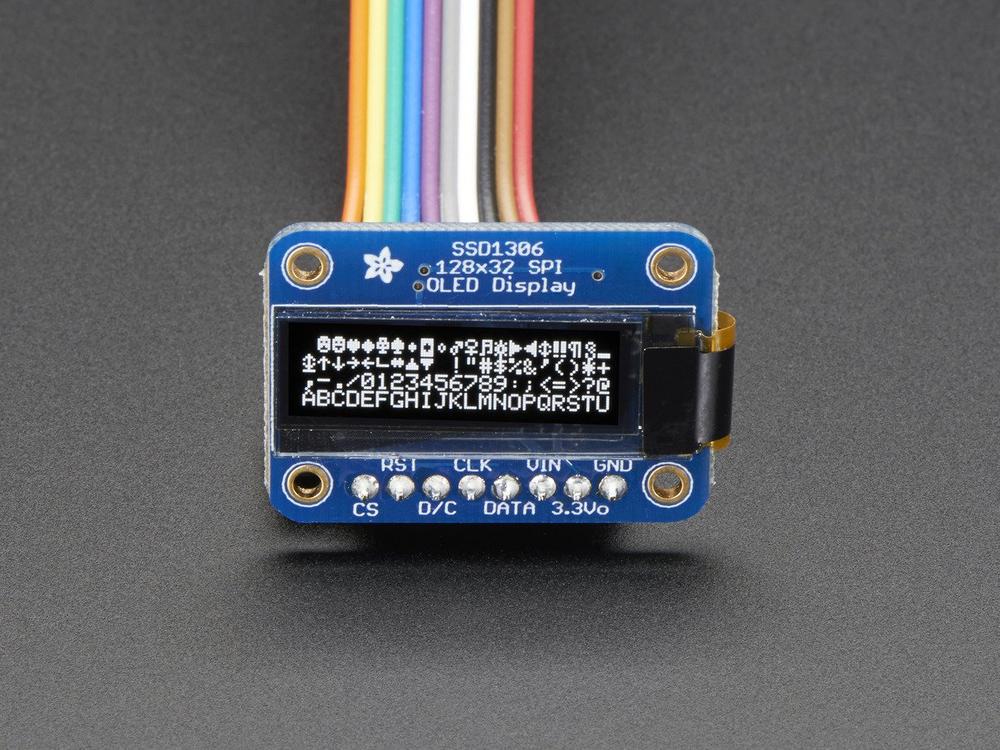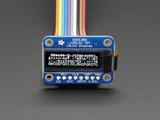Adafruit Monochrome 128x32 SPI OLED graphic display

Description
These displays are compact at just a 1" diagonal yet deliver exceptional readability, thanks to the high contrast of an OLED display. Comprising 128x32 white OLED pixels, each pixel is individually controlled by the onboard driver chip. The self-illuminating nature of the OLED negates the need for a backlight, reducing power consumption and ensuring sharp visuals.
The display utilizes the SSD1306 driver chip, communicating exclusively via SPI and requires 4-5 pins for interfacing. It operates on a 3.3V power supply, supplemented by an integrated 3.3V regulator and level shifter, making it compatible with 5V microcontrollers such as the Arduino.
On average, the display consumes about 20mA from the 3.3V source, contingent upon active pixel count. The driver features a switch-cap charge pump that elevates the voltage to drive the OLEDs efficiently.
For ease of use, users have access to a comprehensive tutorial and Arduino library for graphics and text rendering. Requiring over 512 bytes of RAM, the library can handle text, bitmaps, and basic shapes swiftly. Downloadable from GitHub, it's straightforward to adapt to other microcontrollers.
Each pixel functions as an organic LED. To ensure longevity and avoid dimming, it's advisable to turn off pixels when not in use, particularly if active for extended periods beyond 1000 hours.
Properties
| Brand | Adafruit |
| Model | 661 |
Delivered in 10 to 30 days
Alternative products
- In stock Opencircuit OLED display 128 x 64 SPI - White € 4,95 View product
- In stock Opencircuit OLED display 128 x 64 I2C - Blue € 5,45 View product
- In stock Opencircuit OLED RGB display 96 x 64 SPI € 10,20 View product
- In stock Opencircuit OLED display 128 x 64 - blue - 1.3 "- I2C € 8,55 View product
- In stock Opencircuit OLED display wit 128 x 64 I2C € 4,10 View product
- In stock Pimoroni 1.12" OLED (128x128, white/black) Breakout € 16,80 View product
- In stock Opencircuit OLED display 128 x 32 I2C - Blue € 3,65 View product
- In stock Opencircuit NodeMcu ESP32 OLED Module € 21,55 View product
- In stock Velleman 0.96" oled-display met i2c € 14,70 View product
- Adafruit OLED Breakout Board - 16-bit Color 1.5" w/microSD holder € 45,25 View product
- DFRobot 2.7" OLED 128x64 Display Module € 47,50 View product
- Adafruit OLED Breakout Board - 16-bit Color 1.27" w/microSD holder € 34,- View product
- Opencircuit 0.96 "OLED Display module - yellow / blue - I2C € 6,10 View product
- Kitronik :VIEW Graphics 128 OLED display 128x64 for BBC micro:bit € 13,85 View product
- SparkFun MicroView - OLED Arduino Module € 54,25 View product
- Adafruit FeatherWing OLED - 128x32 OLED Add-on For Feather € 17,- View product
- Adafruit Blue Character OLED 16x2 € 31,50 View product
- LILYGO® TTGO ESP8266 0.91 Inch OLED For Arduino For Nodemcu Development Board € 7,40 View product
- SparkFun Transparent OLED HUD Breakout (Qwiic) € 117,10 View product
Customer questions
Customer Reviews
- In stock Adafruit 2 x CR2032 Coin Cell Battery Holder - 6V output - On/Off switch € 2,25 View product
- In stock Adafruit Woven Conductive Fabric - 20cm square € 5,75 View product
- In stock Adafruit Speaker - 3" Diameter - 4 Ohm 3 Watt € 2,25 View product
- In stock Adafruit NOOds - Flexible LED Filament - 3V 300mm long - Blue € 9,- View product
- In stock Adafruit NOOds - Flexible LED Filament - 3V 300mm long - Warm White € 5,25 View product
- In stock Adafruit Small Enclosed Piezo w/Wires € 1,25 View product
- In stock Adafruit Bone Conductor Transducer with Wires - 8 Ohm 1 Watt € 10,25 View product
- In stock Adafruit MCP9808 High Accuracy I2C Temperature Sensor Breakout Board € 5,75 View product
- In stock Adafruit NOOds - Flexible LED Filament - 3V 300mm long - Lime Green € 8,- View product
- In stock Adafruit VS1053 Codec + MicroSD Breakout - MP3/WAV/MIDI/OGG Play + Record € 28,25 View product
- In stock Adafruit I2S 3W Class D Amplifier Breakout - MAX98357A € 6,75 View product
- 10 pieces In stock Adafruit Break-away 0.1" 36-pin strip male header - Black - 10 pack € 5,75 View product
- In stock Adafruit Conductive Rubber Cord Stretch Sensor + extras! € 11,25 View product
- In stock Adafruit Stereo 3.7W Class D Audio Amplifier - MAX98306 € 10,25 View product
- In stock Adafruit JST PH 2-Pin Cable - Female Connector 100mm € 1,- View product










